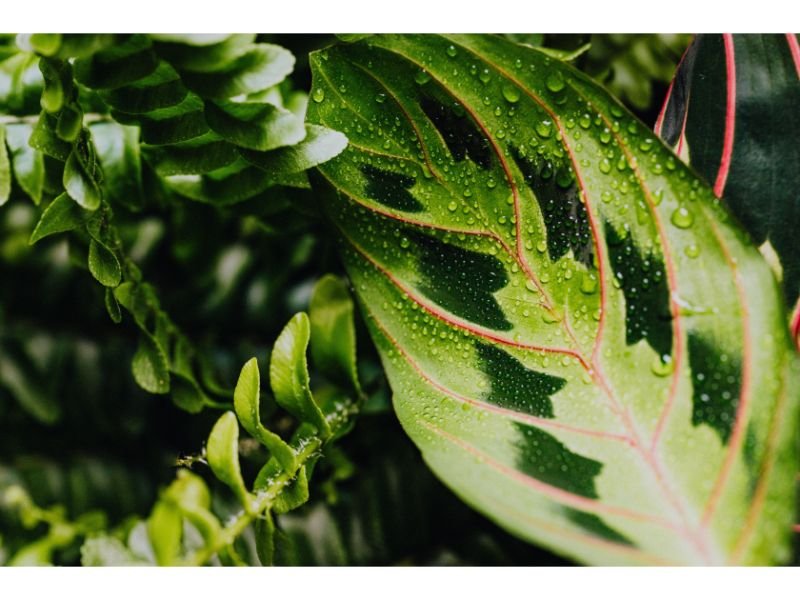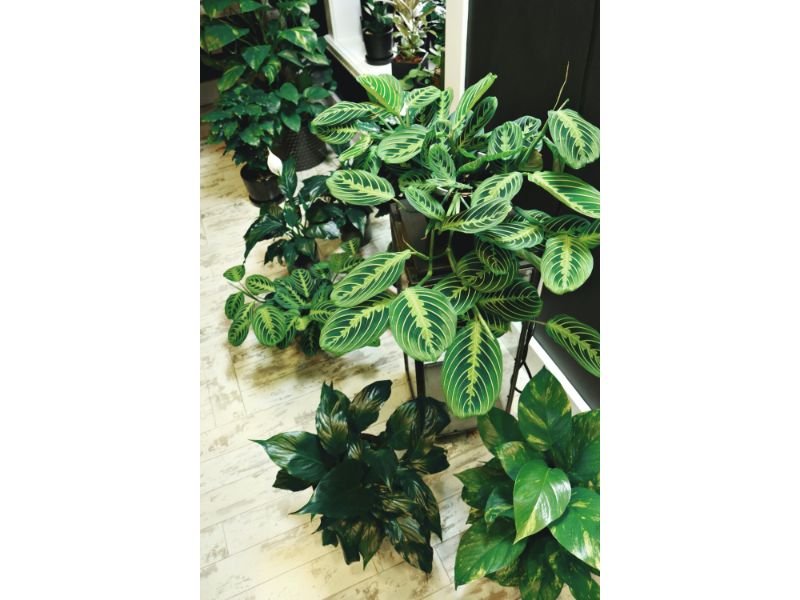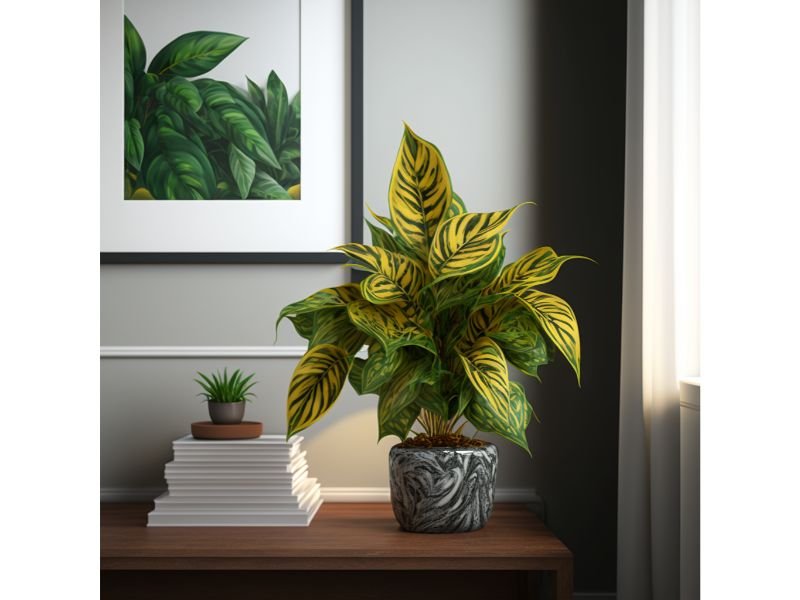Are you looking for a unique and vibrant houseplant to bring your indoor space to life? Look no further than the Lemon Lime Calathea. With its stunning variegated green and yellow foliage, it is sure to be an eye-catching addition to any room! But with this beauty comes responsibility, as Lemon Lime Calatheas require specific care in order to thrive. Read on for our complete guide on how to care for a Lemon Lime Calathea plant!
Table of Contents
Lemon Lime Calathea Care Guide

Light
Most importantly, the light requirements of a Lemon Lime Calathea must be met in order to have a happy and healthy plant. The ideal lighting situation for this species is indirect bright light, meaning plenty of sunshine but not too close that it would cause direct sun scorching. Avoid placing them near windowsills as they will suffer from excessive amounts of heat and humidity. If you’re struggling with providing adequate light levels indoors then adding an artificial grow lamp could help provide enough light during the darker months.
Water
When it comes to watering schedule this beautiful houseplant, aim for keeping the soil moist at all times but not flooded with water. It’s best practice not to allow the soil around their root systems dry out completely before watering again – it’s better slightly more frequent waterings than allowing them dry up between sessions too much. During warmer weather months when temperatures rise above normal levels increase your irrigation frequency accordingly – also consider misting or using pebble trays (for indoor plants). If unsure about moisture levels stick your finger into the soil about one inch deep and check daily – if its damp near damp near top leave otherwise add some more water until desired level achieved
Temperature & Humidity
The ideal temperature range for Lemon Lime Calatheas is between 65–80°F (18–26°C) with higher levels of relative humidity in summer months This tropical species does likes warm climates but avoid placing them next to drafts or cold air sources such as louver doors and windows as these can damage foliage adversely over time A humidifier can be used indoors, especially during wintertime when central heating tends lay decrease available ambient moisture in air.. Lastly use acidified feed products every few weeks during spring/summer while they are actively growing; fertilizing regularly helps keep foliage vibrant throughout year
Potting Mix
It’s important use well draining potting mix when caring for calatheas; store bought soils work great just make sure contain organic matter like composted bark particles or peat moss which will help retain moisture yet still allow excess water drain away freely Potting medium should also include good drainage material such as perlite sphagnum moss which ensure that potted plants never sit waterlogged place saucers beneath planters collect extra liquid after watering sessions
Pruning & Repotting
Fortunately pruning isn’t really necessary lemon lime calatheas if they’ve been properly cared However – if stem length begins outweigh pot size then trim away new growth reduce length repot seasonally generally every two years so that roots are able get access fresh nutrient dense soil environment Furthermore remove dead browning leaf parts order maintain overall attractive healthy appearance of plant.

What are the benefits of growing lemon lime calathea
- Unique and Vibrant Foliage: The Lemon Lime Calathea is known for its striking foliage that features a combination of green and yellow colors. This beautiful foliage makes it an eye-catching addition to any indoor space.
- Air Purifying: As with many houseplants, the Lemon Lime Calathea can help filter indoor air pollutants such as formaldehyde, xylene, and toluene which helps make the air we breathe healthier.
- Low Maintenance Care: Despite its delicate appearance, Lemon Lime Calatheas are relatively low maintenance plants that require minimal effort to maintain their health and beauty. They need indirect bright light, constant moisture in the soil (but not waterlogged), temperatures between 65-80°F (18-26°C), and relative humidity levels during summer months over 50%.
- Stress Relief Benefits: Having a plant at home or in your office can be beneficial for reducing stress levels as studies have shown that interacting with nature can improve feelings of wellbeing, provide grounding moments of presence, and even reduce symptoms of anxiety and depression.
Common pests and diseases and how to handle them
Pests
Lemon Lime Calatheas are susceptible to common houseplant pests such as mealybugs, spider mites, and scale insects. To prevent infestations from occurring in the first place make sure to regularly examine the plant for signs of pests both on leaves and stems. Additionally, If you do notice any signs of pests then immediately isolate the plant away from other plants until it has been dealt with effectively. Depending on the severity of an infestation use a dilute solution of insecticidal soap or horticultural oil to treat the pest problem directly.
Diseases
Unfortunately Lemon Lime Calatheas can also be affected by a range of fungal diseases including leaf spot which presents as yellow-orange spots that spread across leaves quickly if not controlled before they become too severe. To prevent these diseases always ensure adequate air circulation around your plants by providing plenty of distance between them in their growing environment; this will also help reduce humidity levels which is beneficial when it comes to preventing fungal infections. If a disease does appear then carefully spray the infected area with a fungicide product (following instructions thoroughly) and monitor closely for reoccurrences.
The origin of lemon lime calathea

The Lemon Lime Calathea is native to South America, specifically found in the tropical forests of Brazil. This species is part of the genus Maranta known as ‘Prayer Plants’ due to their ability to fold and open their leaves depending on the time of day.
The Lemon Lime Calathea’s leaves fold and open in response to the changes in light intensity throughout the day. This is known as a ‘nyctinastic movement’ which serves as an adaptation to help protect itself from intense midday sunlight. During daylight hours, the leaves will close up while during nighttime they will unfold and open up again. However, this movement of its leaves depends on factors such as light intensity, temperature levels and humidity – if any of these become either too extreme then it can affect the plants ability to move its foliage accordingly.
What are the closes varieties to lemon lime calathea (Alternative)
The closest varieties to the Lemon Lime Calathea are the other members of its genus, Maranta. Some popular species include the Red Prayer Plant (Maranta leuconeura var. erythroneura), the White Calathea (Maranta albo-marginata), and the Rabbit Tracks Calathea (Maranta leuconeura ‘Rabbit Tracks’). All of these plants feature vibrant foliage and require similar care as their Lemon Lime cousin.
Conclusion
Lemon Lime Calatheas are unique and vibrant houseplants that can bring life to any indoor space. With the right care and attention, these beautiful plants can thrive in even the most challenging environments. Remember to provide them with indirect bright light, keep their soil moist but not wet, maintain the right temperature and humidity levels, use a well-draining potting mix, prune and repot as needed and fertilize regularly. With this guide on how to care for your Lemon Lime Calathea plant we are sure you will have a happy and healthy plant in no time!

Gardening is my passion and growing plants indoors has always been a stress relief for me. Grow a banana tree in my apartment once (although failed to produce bananas).






